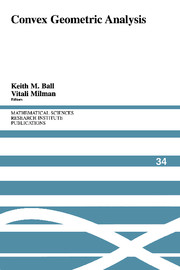Book contents
- Frontmatter
- Contents
- Introduction: The Convex Geometry and Geometric Analysis Program MSRI, Spring 1996
- Msri Program Seminars
- Integrals of Smooth and Analytic Functions over Minkowski's Sums of Convex Sets
- Localization Technique on the Sphere and the Gromov-Milman Theorem on the Concentration Phenomenon on Uniformly Convex Sphere
- Geometric Inequalities in Option Pricing
- Random Points in Isotropic Convex Sets
- Threshold Intervals under Group Symmetries
- On a Generalization of the Busemann-Petty Problem
- Isotropic Constants of Schatten Class Spaces
- On the Stability of the Volume Radius
- Polytope Approximations of the Unit Ball of ℓnp
- A Remark about the Scalar-Plus-Compact Problem
- Another Low-Technology Estimate in Convex Geometry
- On the Equivalence Between Geometric and Arithmetic Means for Log-Concave Measures
- On the Constant in the Reverse Brunn-Minkowski Inequality for p-Convex Balls
- The Extension of the Finite-Dimensional Version of Krivine's Theorem to Quasi-Normed Spaces
- A Note on Gowers' Dichotomy Theorem
- An "Isomorphic" Version of Dvoretzky's Theorem, II
- Asymptotic Versions of Operators and Operator Ideals
- Metric Entropy of the Grassmann Manifold
- Curvature of Nonlocal Markov Generators
- An Extremal Property of the Regular Simplex
- Floating Body, Illumination Body, and Polytopal Approximation
- A Note on the M*-Limiting Convolution Body
The Extension of the Finite-Dimensional Version of Krivine's Theorem to Quasi-Normed Spaces
Published online by Cambridge University Press: 27 June 2025
- Frontmatter
- Contents
- Introduction: The Convex Geometry and Geometric Analysis Program MSRI, Spring 1996
- Msri Program Seminars
- Integrals of Smooth and Analytic Functions over Minkowski's Sums of Convex Sets
- Localization Technique on the Sphere and the Gromov-Milman Theorem on the Concentration Phenomenon on Uniformly Convex Sphere
- Geometric Inequalities in Option Pricing
- Random Points in Isotropic Convex Sets
- Threshold Intervals under Group Symmetries
- On a Generalization of the Busemann-Petty Problem
- Isotropic Constants of Schatten Class Spaces
- On the Stability of the Volume Radius
- Polytope Approximations of the Unit Ball of ℓnp
- A Remark about the Scalar-Plus-Compact Problem
- Another Low-Technology Estimate in Convex Geometry
- On the Equivalence Between Geometric and Arithmetic Means for Log-Concave Measures
- On the Constant in the Reverse Brunn-Minkowski Inequality for p-Convex Balls
- The Extension of the Finite-Dimensional Version of Krivine's Theorem to Quasi-Normed Spaces
- A Note on Gowers' Dichotomy Theorem
- An "Isomorphic" Version of Dvoretzky's Theorem, II
- Asymptotic Versions of Operators and Operator Ideals
- Metric Entropy of the Grassmann Manifold
- Curvature of Nonlocal Markov Generators
- An Extremal Property of the Regular Simplex
- Floating Body, Illumination Body, and Polytopal Approximation
- A Note on the M*-Limiting Convolution Body
Summary
In 1980 D. Amir and V. D. Milman gave a quantitative finitedimensional version of Krivine's theorem. We extend their version of the Krivine's theorem to the quasi-convex setting and provide a quantitative version for p-convex norms.
Recently, a number of results of the Local Theory have been extended to the quasi-normed spaces. There are several works [KalI, Ka12, D, GL, KT, GK, BBP1, BBP2, M2] where such results as Dvoretzky-Rogers lemma [DvR], Dvoretzky theorem [Dv1, Dv2], Milman's subspace-quotient theorem [M1], Krivine's theorem [Kr], Pisier's abstract version of Grotendick's theorem [P1, P2], Gluskin's theorem on Minkowski compact urn [G], Milman's reverse Brunn-Minkowski inequality [M3], and Milman's isomorphic regularization theorem [M4] are extended to quasi-normed spaces after they were established for normed spaces. It is somewhat surprising since the first proofs of these facts substantially used convexity and duality.
In [AM2] D. Amir and V. D. Milman proved the local version of Krivine's theorem (see also [Gow], [MS]). They studied quantitative estimates appearing in this theorem. We extend their result to the q- and quasi-normed spaces. Recall that a quasi-norm on a real vector space X is a map ||·|| : X → ℝ+ satisfying these conditions: Note that I-norm is the usual norm. It is obvious that every q-norm is a quasi-norm with C = 2 1 / q-1 . However, not every quasi-norm is q-norm for some q. Moreover, it is even not necessary continuous. It can be shown by the following simple example.
Information
- Type
- Chapter
- Information
- Convex Geometric Analysis , pp. 139 - 148Publisher: Cambridge University PressPrint publication year: 1999
